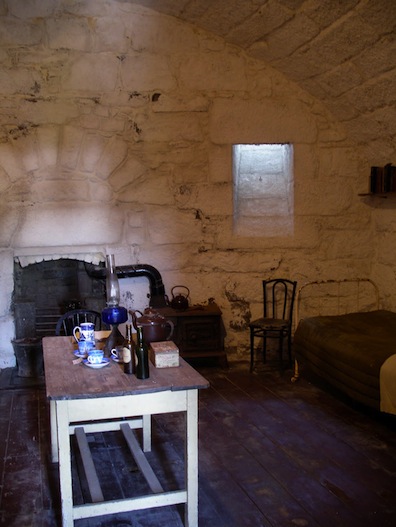"In the gloomy domed livingroom of the tower Buck
Mulligan's gowned form moved briskly about the hearth to and
fro, hiding and revealing its yellow glow. Two shafts of
soft daylight fell across the flagged floor from the high
barbacans." A stove presently vents into the
fireplace, but the narrative makes clear that Mulligan is
cooking over the open fire of the “hearth,” since the yellow
glow of the coals is visible and "a cloud of coalsmoke"
fills the room, choking its inhabitants.
Two shafts of soft daylight are indeed visible in the
photograph at right, slanting into the room from angled wells
that reach up to openings in the thick stone walls that the
narrative refers to as “high barbacans." In Circe the
Black Mass that
Mulligan has mockingly evoked on the top of the tower is
reenacted in this room below, on the second floor, and the
hearthstone becomes an altarstone: "From the high
barbacans of the tower two shafts of light fall on the
smokepalled altarstone."
Barbicans (from French barbacane and Provençal barbacana,
hence perhaps Joyce's spelling) can be towers or other
defensive outer works of a castle, often near a gate or
drawbridge. But as Marc Therre observes in a personal
communication, the OED lists the obsolete meaning of
"A loophole in the wall of a castle or city, through which
missiles might be discharged." Therre notes that "barbacan,"
spelled this way and carrying this sense, is used both in
William Beckford's Gothic novel Vathek (1816) and in
Carlo Botta's History of the War of the Independence of
the United States of America (1826, translated from
the 1809 Italian original).
In a corner of the room opposite to the fireplace, a hammock
has been slung to recreate Trench’s
sleeping conditions, mentioned twice in Telemachus:
"A tall figure rose from the hammock where it had been
sitting"; “he took his soft grey hat from
the holdfast of the hammock.” (The word holdfast
apparently refers to a bolt anchored in the stone wall.)
Joyce's bed was probably to the left, between Trench's hammock
and the fireplace.
In Trench’s
nightmare, a black panther was crouching on the hearth,
waiting to spring, and the Englishman fired his revolver in
the direction of the fireplace, quite close to Joyce's bed.
The curators of the museum have installed a kitschy statue to
play the part of the beast.
The "heavy door" which Mulligan cries out to
have opened, itself accessed by two "inner doors,"
is different from the opening that leads via steep stone stairs up to the
roof. It leads down from the second-story livingroom to the
ground via a "ladder." In 1904, this door afforded the
only entrance to the tower, and the large key mentioned
repeatedly in the narrative allowed the iron door at the top
to be locked. Today, an opening has been cut into the tower on
the ground floor as an entrance to the museum.
When breakfast is finished, the three men exit the tower
through this exterior door on their way to the swimming hole.



